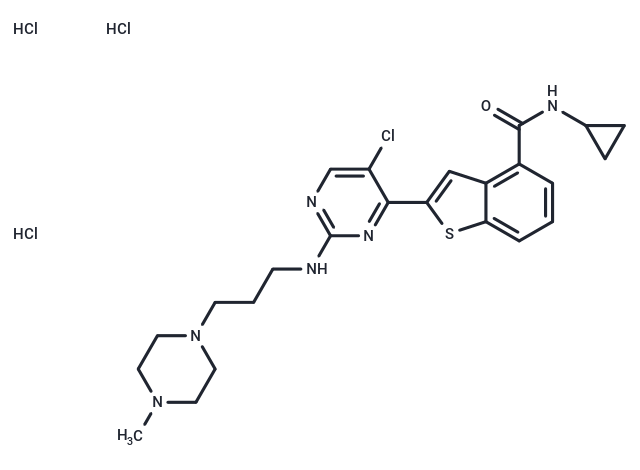Shopping Cart
- Remove All
 Your shopping cart is currently empty
Your shopping cart is currently empty

LY2409881 trihydrochloride is a novel specific inhibitor of IKK2 (IC50: 30 nM); IC50 for IKK1 and other common kinases is at least one log higher.

| Pack Size | Price | Availability | Quantity |
|---|---|---|---|
| 1 mg | $45 | In Stock | |
| 2 mg | $64 | In Stock | |
| 5 mg | $98 | In Stock | |
| 10 mg | $177 | In Stock | |
| 25 mg | $246 | In Stock | |
| 50 mg | $317 | In Stock | |
| 100 mg | $496 | In Stock | |
| 1 mL x 10 mM (in DMSO) | $139 | In Stock |
| Description | LY2409881 trihydrochloride is a novel specific inhibitor of IKK2 (IC50: 30 nM); IC50 for IKK1 and other common kinases is at least one log higher. |
| Targets&IC50 | IKK2:30 nM |
| In vitro | LY240988 was moderately toxic to ovarian cancer SKOV3 cell line. In diffuse large B-cell lymphoma cells, LY2409881 inhibited activated NF-?B, concentration- and time-dependently inhibiting cell growth and causing apoptosis. In SUDHL2 cells, LY2409881 inhibited cell growth synergistically with cyclophosphamide and adriamycin, but had no synergistic effect on LY1 cells. In SUDHL22 and LY1 cells, histone deacetylase inhibitor romidepsin synergized with LY2409881 to inhibit cell growth. |
| In vivo | LY240988 was moderately toxic to ovarian cancer SKOV3 cell line. In diffuse large B-cell lymphoma cells, LY2409881 inhibited activated NF-?B, concentration- and time-dependently inhibiting cell growth and causing apoptosis. In SUDHL2 cells, LY2409881 inhibited cell growth synergistically with cyclophosphamide and adriamycin, but had no synergistic effect on LY1 cells. In SUDHL22 and LY1 cells, histone deacetylase inhibitor romidepsin synergized with LY2409881 to inhibit cell growth. |
| Kinase Assay | CYP3A activity is assessed using the probe reactions, midazolam-1′-hydroxylation and testosterone 6β-hydroxylation. For reversible inhibition, incubations (37°C, 10 min) are composed of (final concentrations): potassium phosphate buffer (100 mM, pH 7.4), β-NADPH (1 mM), magnesium chloride (5 mM), microsomal protein (0.025 mg/mL), probe substrate (1 μM midazolam or 25 μM testosterone), LCL161 (0, 0.5, 1, 5, 10, 25, 50, or 100 μM) and organic solvent (0.2% acetonitrile for midazolam, 0.2% methanol for testosterone). After a 3-minute preincubation, the reactions are initiated by addition of β-NADPH and terminated by addition of acetonitrile (two volumes). Reactions are previously shown to be linear with respect to time and protein concentration (results not shown) with midazolam and testosterone turnover of 8.7±1.3% (n=3) and 2.6±0.20%, respectively. Formation of 1′-hydroxymidazolam and 6β-hydroxytestosterone is determined by LC-MS/MS as described below[3]. |
| Cell Research | Cytotoxicity is evaluated using the CellTiter-Glo Reagent according to the manufacturer's manual. Experiments are carried out in 96-well plates, with each treatment in triplicate. Samples are taken at typically 24, 48, and 72 hours after treatment. Cytotoxicity is expressed by the decreasing percentage of live cells in each treatment relative to the untreated control from the same experiment. IC50 for each cell line is calculated using the CalcuSyn Version 2.0 software.(Only for Reference) |
| Molecular Weight | 594.43 |
| Formula | C24H32Cl4N6OS |
| Cas No. | 946518-60-1 |
| Smiles | Cl.Cl.Cl.CN1CCN(CCCNc2ncc(Cl)c(n2)-c2cc3c(cccc3s2)C(=O)NC2CC2)CC1 |
| Relative Density. | no data available |
| Storage | Powder: -20°C for 3 years | In solvent: -80°C for 1 year | Shipping with blue ice. | |||||||||||||||||||||||||
| Solubility Information | DMSO: 16 mg/mL (26.9 mM) Ethanol: < 1 mg/mL (insoluble or slightly soluble) H2O: < 1 mg/mL (insoluble or slightly soluble) | |||||||||||||||||||||||||
Solution Preparation Table | ||||||||||||||||||||||||||
DMSO
| ||||||||||||||||||||||||||

Copyright © 2015-2024 TargetMol Chemicals Inc. All Rights Reserved.